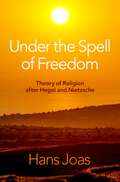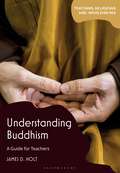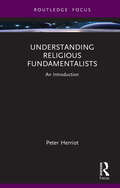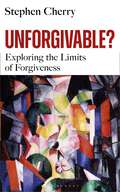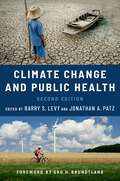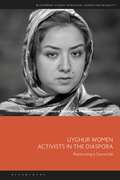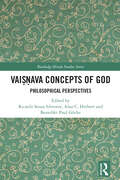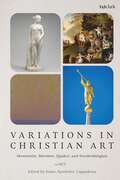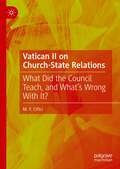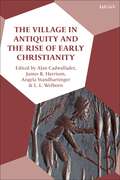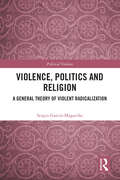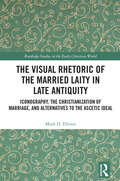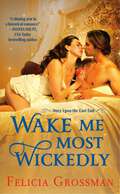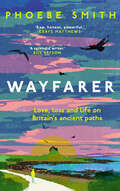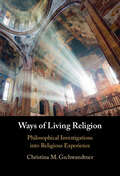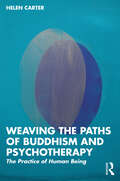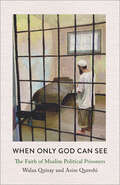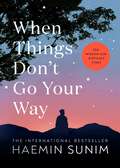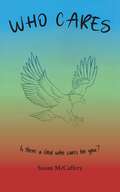- Table View
- List View
Under the Spell of Freedom: Theory of Religion after Hegel and Nietzsche
by Hans JoasHow do the history of religion and the history of political freedom relate to each other? The variety of views on this subject in philosophy, the humanities and social sciences, and the public is broad and confusing. But the grandiose synthesis in which Hegel brought together Christianity and political freedom is still an enormous source of orientation for many-despite or even because of the influential provocations of Friedrich Nietzsche. As Hans Joas shows in Under the Spell of Freedom, a different view has developed in the religious thinking of the twentieth century based on a conception of history that is more open to the future and on a concept of freedom that is richer than that of Hegel. Using sixteen selected thinkers, Joas deconstructs the grand Hegelian narrative of human history as the self-realization of the idea of freedom, setting as a counterpart the sketches of a theory of the emergence of moral universalism. Further, taking the classical views of Hegel and his emphasis on the role of Protestant Christianity and the extremely negative views about Christianity in the work of the philosopher Friedrich Nietzsche, Joas elaborates on this new understanding of religion and freedom, which avoids both Eurocentrism and an intellectualist view of religious faith and practice. The result is a forceful plea for a global history of moral universalism. Under the Spell of Freedom is an important step in this direction.
Understanding Buddhism: A Guide for Teachers (Teaching Religions and Worldviews)
by James D. HoltBuddhism is often the religion that teachers have the least confidence in teaching despite being the sixth largest religion in the UK and being commonly regarded as one of the six major religions to be taught in schools throughout the country. This book explores the beliefs and practices of Buddhism as a lived religion in the UK. This book engages with Buddhist beliefs and practices and provides students and teachers with the confidence to address misconceptions and recognise the importance of beliefs in the lives of believers, in a way that will enable readers to go forward with confidence. Aspects of Buddhism explored include the concepts that form the central beliefs of Buddhism, and then the expression of these beliefs in worship, daily life, and the ethics of Buddhists in the modern day. Each chapter includes authentic voices of believers today and provides opportunities for the reader to consider the concepts and how they can be respected and taught and in the classroom.The book forms part of the Teaching Religions and Worldviews series of guides, each one designed to build teachers' confidence and expertise in teaching a different religion or worldview in the classroom..
Understanding Religious Fundamentalists: An Introduction (Routledge Focus on Religion)
by Peter HerriotThis book introduces the prominent role that fundamentalists play in religious, cultural, and political arenas.It begins by investigating religious fundamentalist groups and their psychological motivations for this counter-cultural adherence. Their extremely varied actions, argues the author, are based on two fundamental beliefs: that God speaks to them personally through his Word; and that they are involved in a cosmic war between God and Satan.. Subsequent chapters explore how fundamentalisms meet universal psychological needs for meaning, identity, agency, and self-esteem. Moving from individual psychology to social context, the latter half of the book explores how fundamentalist movements derive and exercise their authority and how leaders may strategise to appeal to external societies. The closing chapters seek to place the growth of fundamentalisms and their continued popularity in the social context of modernity and populism.With engaging discussion questions and suggestions for further reading, this book is ideal for students of social science and religion, as well as readers interested in the psychological roots of fundamentalism.
Understanding Religious Fundamentalists: An Introduction (Routledge Focus on Religion)
by Peter HerriotThis book introduces the prominent role that fundamentalists play in religious, cultural, and political arenas.It begins by investigating religious fundamentalist groups and their psychological motivations for this counter-cultural adherence. Their extremely varied actions, argues the author, are based on two fundamental beliefs: that God speaks to them personally through his Word; and that they are involved in a cosmic war between God and Satan.. Subsequent chapters explore how fundamentalisms meet universal psychological needs for meaning, identity, agency, and self-esteem. Moving from individual psychology to social context, the latter half of the book explores how fundamentalist movements derive and exercise their authority and how leaders may strategise to appeal to external societies. The closing chapters seek to place the growth of fundamentalisms and their continued popularity in the social context of modernity and populism.With engaging discussion questions and suggestions for further reading, this book is ideal for students of social science and religion, as well as readers interested in the psychological roots of fundamentalism.
Unforgivable?: Exploring the Limits of Forgiveness
by Stephen CherryForgiveness is a lovely idea, wrote C. S. Lewis, and in recent decades it has been seen and admired in situations ranging from therapy to politics, and proposed as a constructive pathway in the aftermath of abuse and atrocity. Not everyone is impressed, however, and in parallel with praise and promotion of forgiveness, cries of 'unforgivable' are uttered with increased shrillness and frequency. In this hugely compelling, wide-ranging, and thought-provoking book, Stephen Cherry argues that while forgiveness can be transformative in the aftermath of harm, it can also, if not handled with care, become an additional pressure and anxiety for those who have been harmed. He teases out the way in which Christian understandings often lie behind pressure to forgive, identifying a number of typical mistakes with the Christian approach to forgiveness. Reflecting on many examples from real life as well as literature, and on the insights of psychologists and philosophers, Cherry uses the tension between the desire to forgive and the protest that a person is unforgivable to push towards understandings of forgiveness that avoid the harshness of binary models. Forgiveness is not, he insists, the only good way forward after harm. A positive understanding of non-vengeful unforgiveness is vital if the harmed are to be given the care and support they need and deserve, and if forgiveness itself is to be authentic and liberating. Cherry's challenging book brims with energy and blends human insight with intellectual vision. It argues that if forgiveness is to play a part in the aftermath of harm without inflicting further harm it must be presented in a non-idealized way and only following acknowledgement of the depth of the human impact of the harm done.
The Unknown God: W. T. Smith and the Thelemites (Oxford Studies in Western Esotericism)
by Martin P. StarrThe Unknown God is the first documentary study of Thelema, a twentieth-century religious movement in the "magical" family, founded by the occultist, poet, and prophet of a new age of personal freedom, Aleister Crowley (1875--1947). Martin P. Starr tells the history of the movement through the biography of its leader, Wilfred Talbot Smith (1885--1957), who took up Crowley's plans for organizations to teach the latter's methods in Western and Eastern esoteric traditions and his laws for a new world order, and established these systems in British Columbia and in California. Crowley provided the concepts; Smith and his associates made them take flesh, applying Crowley's doctrine of "Do what thou wilt" and cementing it a part of the artistic and religious underground of the twentieth century. This account provides a contextual overview of the elements of the resulting bricolage of religions, which included Freemasonry, Theosophy, Rosicrucianism, Neo-Gnosticism and other related forms of esotericism, demonstrating the overlap between apparently disparate ideologies, groups, and participants. Drawing primarily on diaries and letters, Starr gives a rare and fascinating study of the contemporaneous application of Crowley's thought, whose long trail we can see in the Satanism of Anton LaVey, the Scientology of L. Ron Hubbard, and the popularization of many forms of witchcraft, magic, and tantric practices.
Uyghur Women Activists in the Diaspora: Restorying a Genocide (Bloomsbury Studies in Religion, Gender, and Sexuality)
by Susan J. Palmer Dilmurat Mahmut Abdulmuqtedir UdunPresenting the life stories of ten Uyghur women, this book applies the techniques of narrative analysis to explore their changing worldviews and conversions to political engagement. Born and raised in East Turkestan/Xinjiang in the 1970s-90s, each woman, after personally experiencing incidents of ethnic discrimination, chose to leave China before 2005. Settling in a western country, they strive to become the voice of the Turkic people who are silenced or detained in the “re-education” camps.The narratives are based on interviews conducted online between 2020 and 2021, collected as a form of oral history. The book focuses on the escalating tensions, turning points experienced in their youth, and the religious, political and psychological factors that prompted their transformations in self-identity, ideology and the emergence of a new Uyghur–Muslim feminism.Through the women's stories, the book describes how women activists are navigating the competing reality constructions of the dire situation in the Uyghur Homeland and actively restorying a genocide to bring about social and political change.
Vaiṣṇava Concepts of God: Philosophical Perspectives (Routledge Hindu Studies Series)
This book explores a number of concepts of God in Vaiṣṇavism, which is commonly referred to as one of the great Hindu monotheistic traditions. By addressing the question of what attributes God possesses according to particular Vaiṣṇava textual sources and traditions, the book locates these concepts within a global philosophical framework. The book is divided into two parts. The first part, God in Vaiṣṇava Texts, deals with concepts of God found in some of the more prominent canonical Vaiṣṇava texts: the Bhagavad-Gītā, the Bhagavata-Purāṇa, the Jayākhya-Saṃhitā as representative of the Pāñcarātras, and the Mahābhārata. The second part, God in Vaiṣṇava Traditions, addresses concepts of God found in several Vaiṣṇava traditions and their respective key theologians. In addition to the Āḻvārs, the five traditional Vaiṣṇava schools—the Śrī Vaiṣṇava tradition, the Madhva tradition, the Nimbārka tradition, the Puṣṭimārga tradition, and the Caitanya Vaiṣṇava tradition—and two contemporary ones—those of Ramakrishna (who has Vaiṣṇava leanings) and Swami Bhaktivedanta—are considered. The book combines normative, critical, and descriptive elements. Some chapters are philosophical in nature, and others are more descriptive. Each unpacks a specific Vaiṣṇava concept of God for future philosophical analysis and critique. Written by experts who break new ground in this presentation and representation of the diversity of Vaiṣṇava texts and traditions, the book provides approaches that reflect the amount of philosophical and historical deliberation on the specific issues and divine attributes so far considered in the field of Hindu Studies. This book will be of interest to researchers in disciplines including philosophy of religion and Indian philosophy, cross-cultural and comparative philosophy, analytic philosophy of religion, Hindu Studies, theology, and religious studies.
Vaiṣṇava Concepts of God: Philosophical Perspectives (Routledge Hindu Studies Series)
by Ricardo Sousa Silvestre Alan C. Herbert Benedikt Paul GöckeThis book explores a number of concepts of God in Vaiṣṇavism, which is commonly referred to as one of the great Hindu monotheistic traditions. By addressing the question of what attributes God possesses according to particular Vaiṣṇava textual sources and traditions, the book locates these concepts within a global philosophical framework. The book is divided into two parts. The first part, God in Vaiṣṇava Texts, deals with concepts of God found in some of the more prominent canonical Vaiṣṇava texts: the Bhagavad-Gītā, the Bhagavata-Purāṇa, the Jayākhya-Saṃhitā as representative of the Pāñcarātras, and the Mahābhārata. The second part, God in Vaiṣṇava Traditions, addresses concepts of God found in several Vaiṣṇava traditions and their respective key theologians. In addition to the Āḻvārs, the five traditional Vaiṣṇava schools—the Śrī Vaiṣṇava tradition, the Madhva tradition, the Nimbārka tradition, the Puṣṭimārga tradition, and the Caitanya Vaiṣṇava tradition—and two contemporary ones—those of Ramakrishna (who has Vaiṣṇava leanings) and Swami Bhaktivedanta—are considered. The book combines normative, critical, and descriptive elements. Some chapters are philosophical in nature, and others are more descriptive. Each unpacks a specific Vaiṣṇava concept of God for future philosophical analysis and critique. Written by experts who break new ground in this presentation and representation of the diversity of Vaiṣṇava texts and traditions, the book provides approaches that reflect the amount of philosophical and historical deliberation on the specific issues and divine attributes so far considered in the field of Hindu Studies. This book will be of interest to researchers in disciplines including philosophy of religion and Indian philosophy, cross-cultural and comparative philosophy, analytic philosophy of religion, Hindu Studies, theology, and religious studies.
Variations in Christian Art: Mennonite, Mormon, Quaker, and Swedenborgian
by Diane Apostolos-CappadonaThe artistic traditions of four major Christian denominations are examined and outlined in detail in this groundbreaking volume that presents the first synthesis of the artistic contributions of those traditions. Diane Apostolos-Cappadona has curated a volume that presents four single-authored contributions in one place, broadening the study of Christian art beyond Roman Catholic, Orthodox and 'protestant' traditions to consider these more recent Christian approaches in close and expert detail. Rachel Epp Buller examines art in the Mennonite tradition, Mormon art is considered by Heather Belnap, Quaker contributions by Rowena Loverance and Swedenborgian art by Diane Apostolos-Cappadona. Each writer presents elements of the theology of their chosen tradition through the prism of the artists and artistic works that they have selected. Alongside mainstream artistic figures such as William Blake less known figures come to the fore and the volume features color illustrations that support and underline the theological and artistic themes presented in each section of the book. Together these studies of artistic presentations in these four traditions will be a much need means of filling a gap in the study of Christian art.
Vatican II on Church-State Relations: What Did the Council Teach, and What's Wrong With It?
by M. Y. CiftciShould religion and politics be kept apart? What should be the relationship between the church and the state? M.Y. Ciftci answers these questions by studying the most important event in the recent history of the Catholic Church: The Second Vatican Council (1962-65). The book provides a new interpretation of the Council’s teaching on church-state relations to better appreciate its flaws and need for reform. By paying attention to the (often overlooked) importance given by the Council to the lay apostolate, it reveals how the Council did not reform, as is often thought, but retained a flawed conception of the laity’s role in politics. It then proposes a new framework for understanding church-state relations using the ressourcement method of returning to scripture and tradition, and by a critical dialogue with Oliver O’Donovan and various Protestant biblical scholars of the Powers in the New Testament. Ciftci shows how fruitful an self-consciously ecumenical approach can be for political theology. As most ressourcement theologians have overlooked political issues, and since ecumenical theology rarely touches on issues of church-state relations, this work makes an original contribution to the ressourcement project and to ecumenism.
Veiled Threat: On being visibly Muslim in Britain
by Nadeine AsbaliNadeine Asbali would be the first to say that a scarf on a woman's head doesn't define her, but in her case, that's a lie. Nadeine's life changed overnight. As a mixed-race teenager, she had unknowingly been passing as white her entire life: until she decided to wear the hijab. Then, in an instant, she went from being an unassuming white(ish) child to something sinister and threatening, perverse and foreign. Veiled Threat is a sharp and illuminating examination of what it is to be a visibly Muslim woman in modern Britain, a nation intent on forced assimilation and integration and one that views covered bodies as primitive and dangerous. From being bombarded by racist stereotypes to being subjected to structural inequalities on every level, Nadeine asks why Muslim women are forced to contend with the twin oppressions of state-sanctioned Islamophobia and the unrelenting misogyny that fuels our world, all whilst being told by white feminists that they need saving. Combining a passionate argument with personal experience, Veiled Threat is an indictment of a divided Britain that dominates and systematically others Muslim women at every opportunity.
The Village in Antiquity and the Rise of Early Christianity
by Alan H. Cadwallader, James R. Harrison,Angela Standhartinger and L. L. WelbornA complete geographical and thematic overview of the village in an antiquity and its role in the rise of Christianity. The volume begins with a “state-of-question” introduction by Thomas Robinson, assessing the interrelation of the village and city with the rise of early Christianity. Alan Cadwallader and James R. Harrison then articulate a methodology for future New Testament studies on this topic, employing a series of case studies to illustrate the methodological issues raised.From there contributors explore three areas of village life in different geographical areas, by means of a series of studies, written by experts in each discipline. They discuss the ancient near east (Egypt and Israel), mainland and Isthmian Greece, Asia Minor, and the Italian Peninsula. This geographic focus sheds light upon the villages associated with the biblical cities (Israel; Corinth; Galatia; Ephesus; Philippi; Thessalonica; Rome), including potential insights into the rural nature of the churches located there.A final section of thematic studies explores central issues of local village life (indigenous and imperial cults, funerary culture, and agricultural and economic life).
Violence, Politics and Religion: A General Theory of Violent Radicalization (ISSN)
by Sergio García-MagariñoThis book offers a general theory of violent radicalization and uses case studies from a variety of different countries and groups to illustrate this.The first and fundamental objective of the book is to provide an explanatory framework to understand phenomena related to violent radicalization, deradicalization, the prevention of radicalization and to political violence; in particular, that inspired by religion. The second objective follows from the first. Understanding violent radicalization of religious inspiration implies delving into two key concepts: violent radicalization and religion. This second objective is indeed elusive, since, on the one hand, many liberal democracies have undergone processes of secularization or, at least, have lost interest in examining religion in public debates. Therefore, rigorously exploring social problems where religion seems to be involved, in one way or another, is complicated. Moreover, the notion of violent radicalization, in turn, is highly contested and confused with other ideas, such as polarization, extremism, terrorism or nonviolent radicalization. Finally, the book aims to bring theory into dialogue with empirical phenomena, and to test it against concrete cases related to violent radicalization and its prevention, on the one hand, and religion, on the other. The book’s originality comes from both its innovative, methodological approach and its breadth, with cases from several countries (Spain, the United States, Ireland, India, Israel, Russia and Colombia) and different ideological groups (revolutionary communists, nationalist movements, Jihadist groups, white and black supremacists).This book will be of much interest to students of terrorism and political violence, radicalization, sociology and international relations in general.
Violence, Politics and Religion: A General Theory of Violent Radicalization (ISSN)
by Sergio García-MagariñoThis book offers a general theory of violent radicalization and uses case studies from a variety of different countries and groups to illustrate this.The first and fundamental objective of the book is to provide an explanatory framework to understand phenomena related to violent radicalization, deradicalization, the prevention of radicalization and to political violence; in particular, that inspired by religion. The second objective follows from the first. Understanding violent radicalization of religious inspiration implies delving into two key concepts: violent radicalization and religion. This second objective is indeed elusive, since, on the one hand, many liberal democracies have undergone processes of secularization or, at least, have lost interest in examining religion in public debates. Therefore, rigorously exploring social problems where religion seems to be involved, in one way or another, is complicated. Moreover, the notion of violent radicalization, in turn, is highly contested and confused with other ideas, such as polarization, extremism, terrorism or nonviolent radicalization. Finally, the book aims to bring theory into dialogue with empirical phenomena, and to test it against concrete cases related to violent radicalization and its prevention, on the one hand, and religion, on the other. The book’s originality comes from both its innovative, methodological approach and its breadth, with cases from several countries (Spain, the United States, Ireland, India, Israel, Russia and Colombia) and different ideological groups (revolutionary communists, nationalist movements, Jihadist groups, white and black supremacists).This book will be of much interest to students of terrorism and political violence, radicalization, sociology and international relations in general.
The Visual Rhetoric of the Married Laity in Late Antiquity: Iconography, the Christianization of Marriage, and Alternatives to the Ascetic Ideal (Routledge Studies in the Early Christian World)
by Mark D. EllisonThis study examines third- and fourth-century portraits of married Christians and associated images, reading them as visual rhetoric in early Christian conversations about marriage and celibacy, and recovering lay perspectives underrepresented or missing in literary sources. Historians of early Christianity have grown increasingly aware that written sources display an enthusiasm for asceticism and sexual renunciation that was far from representative of the lives of most early Christians. Often called a “silent majority,” the married laity in fact left behind a significant body of work in the material record. Particularly in and around Rome, they commissioned and used such objects as sarcophagi, paintings, glass vessels, finger rings, luxury silver, other jewellery items, gems, and seals that bore their portraits and other iconographic forms of self-representation. This study is the first to undertake a sustained exploration of these material sources in the context of early Christian discourses and practices related to marriage, sexuality, and celibacy. Reading this visual evidence increases understanding of the population who created it, the religious commitments they asserted, and the comparatively moderate forms of piety they set forth as meritorious alternatives to the ascetic ideal. In their visual rhetoric, these artifacts and images comprise additional voices in Late Antique conversations about idealized ways of Christian life, and ultimately provide a fuller picture of the early Christian world. Plentifully illustrated with photographs and drawings, this volume provides readers access to primary material evidence. Such evidence, like textual sources, require critical interpretation; this study sets forth a careful methodology for iconographic analysis and applies it to identify the potential intentions of patrons and artists and the perceptions of viewers. It compares iconography to literary sources and ritual practices as part of the interpretive process, clarifying the ways images had a rhetorical edge and contributed to larger conversations. Accessibly written, The Visual Rhetoric of the Married Laity in Late Antiquity is of interest to students and scholars working on Late Antiquity, early Christian and late Roman social history, marriage and celibacy in early Christianity, and early Christian, Roman, and Byzantine art.
The Visual Rhetoric of the Married Laity in Late Antiquity: Iconography, the Christianization of Marriage, and Alternatives to the Ascetic Ideal (Routledge Studies in the Early Christian World)
by Mark D. EllisonThis study examines third- and fourth-century portraits of married Christians and associated images, reading them as visual rhetoric in early Christian conversations about marriage and celibacy, and recovering lay perspectives underrepresented or missing in literary sources. Historians of early Christianity have grown increasingly aware that written sources display an enthusiasm for asceticism and sexual renunciation that was far from representative of the lives of most early Christians. Often called a “silent majority,” the married laity in fact left behind a significant body of work in the material record. Particularly in and around Rome, they commissioned and used such objects as sarcophagi, paintings, glass vessels, finger rings, luxury silver, other jewellery items, gems, and seals that bore their portraits and other iconographic forms of self-representation. This study is the first to undertake a sustained exploration of these material sources in the context of early Christian discourses and practices related to marriage, sexuality, and celibacy. Reading this visual evidence increases understanding of the population who created it, the religious commitments they asserted, and the comparatively moderate forms of piety they set forth as meritorious alternatives to the ascetic ideal. In their visual rhetoric, these artifacts and images comprise additional voices in Late Antique conversations about idealized ways of Christian life, and ultimately provide a fuller picture of the early Christian world. Plentifully illustrated with photographs and drawings, this volume provides readers access to primary material evidence. Such evidence, like textual sources, require critical interpretation; this study sets forth a careful methodology for iconographic analysis and applies it to identify the potential intentions of patrons and artists and the perceptions of viewers. It compares iconography to literary sources and ritual practices as part of the interpretive process, clarifying the ways images had a rhetorical edge and contributed to larger conversations. Accessibly written, The Visual Rhetoric of the Married Laity in Late Antiquity is of interest to students and scholars working on Late Antiquity, early Christian and late Roman social history, marriage and celibacy in early Christianity, and early Christian, Roman, and Byzantine art.
Wake Me Most Wickedly (Once Upon the East End)
by Felicia GrossmanBookPage Most Anticipated Romances of 2024 &“No one writes love stories with more heart, more swoons, and more sizzle&” (Joanna Shupe, USA Today bestselling author) in this clever reimaging of Snow White, where a handsome businessman will do anything to win the heart of the only woman he cannot have. Solomon Weiss has little interest in power, but to repay the half-brother who raised him, he pursues money, influence, and now—a respectable wife. That is, until outcast Hannah Moses saves his life, and Sol finds himself helplessly drawn to the beautiful pawnshop owner. Forever tainted by her parents' crimes, Hannah sees only a villain when she looks in the mirror—no one a prince would choose. To survive, she must care for herself, even if that means illegally hunting down whatever her clients wish. So, no matter how fair or charming she finds Sol, he belongs to a world far too distant from her own. Only neither can resist their desires, and each meeting weakens Hannah&’s resolve to stay away. But when Hannah discovers a shocking betrayal in Sol&’s inner circle, can she convince him to trust her? Or will fear and doubt poison their love for good?
Wayfarer: Love, Loss And Life On Britain's Ancient Paths
by Phoebe SmithA woman’s tale of the transformative power of walking Britain’s ancient pilgrim paths ‘Raw, honest, powerful. I couldn't put it down.’ Cerys Matthews
Ways of Living Religion: Philosophical Investigations into Religious Experience
by null Christina M. GschwandtnerWays of Living Religion provides a philosophical analysis of different types of religious experience - ascetic, liturgical, monastic, mystical, devotional, compassionate, fundamentalist - that focuses on the lived experience of religion rather than reducing it to mere statements of belief or doctrine. Using phenomenology, Christina M. Gschwandtner distinguishes between different kinds of religious experiences by examining their central characteristics and defining features, as well as showing their continuity with human experience more broadly. The book is the first philosophical examination of several of these types, thus breaking new ground in philosophical thinking about religion. It is neither a confessional treatment nor a reduction of the lived experience to psychological or sociological phenomena. While Gschwandtner's treatment focuses on Christian forms of expression of these different types, it opens the path to broader examinations of ways of living religion that might enable scholars to give a more nuanced account of their similarities and differences.
Weaving the Paths of Buddhism and Psychotherapy: The Practice of Human Being
by Helen CarterWeaving the Paths of Buddhism and Psychotherapy is an empathic guide to integrating Eastern and Western wisdom traditions that share the common goal of easing distress. Following the so-called ‘mindfulness revolution’ there has been a surge in interest as to how Buddhism’s overarching view on suffering may enhance therapeutic practice. This book is not just a clinical text; it is a first-person account of one Buddhist therapist educator’s lived experience of bringing Buddhism into the very personal and relational experience of psychotherapy. Western-trained therapists will recognize key concepts: the existential underpinnings of distress, driver behaviour and scripts, modifications to contact such as projection and introjection, relational conditions for healing, ethical considerations, and working with complex presentations and trauma, among others. Through autobiographical vignettes and case-study material, the book offers an invitation to all therapists to consider their own practice of human being.
Weaving the Paths of Buddhism and Psychotherapy: The Practice of Human Being
by Helen CarterWeaving the Paths of Buddhism and Psychotherapy is an empathic guide to integrating Eastern and Western wisdom traditions that share the common goal of easing distress. Following the so-called ‘mindfulness revolution’ there has been a surge in interest as to how Buddhism’s overarching view on suffering may enhance therapeutic practice. This book is not just a clinical text; it is a first-person account of one Buddhist therapist educator’s lived experience of bringing Buddhism into the very personal and relational experience of psychotherapy. Western-trained therapists will recognize key concepts: the existential underpinnings of distress, driver behaviour and scripts, modifications to contact such as projection and introjection, relational conditions for healing, ethical considerations, and working with complex presentations and trauma, among others. Through autobiographical vignettes and case-study material, the book offers an invitation to all therapists to consider their own practice of human being.
When Only God Can See: The Faith of Muslim Political Prisoners
by Walaa Quisay Asim Qureshi‘This beautifully written and harrowing book bears witness to the devastating experience of imprisonment; it shows the centrality of faith; and tenderly details the prayers, communities and acts of resistance that sustained these prisoners when faced with forced disappearance, punishment, and torture’ Laleh Khalili, author of Time in the Shadows‘A passionate revelation of the secret endurance of people suffering extraordinary trauma ... A must read to understand the limitless potential of the human spirit’ Aida Seif El-Dawla, psychiatrist and co-founder of El Nadeem Centre for Rehabilitation of Victims of Violence and TortureWhen Only God Can See uncovers the unique experiences of Muslim political prisoners held in Egypt and under US custody at Guantanamo Bay and other detention black sites. This groundbreaking book explores the intricate interplay between their religious beliefs, practices of ritual purity, prayer, and modes of resistance in the face of adversity. Highlighting the experiences of these prisoners, faith is revealed to be not only a personal spiritual connection to God, but also a means of contestation against prison and state authorities, reflecting larger societal struggles.Written by Walaa Quisay, who has worked closely with prisoners in Egypt, and Asim Qureshi, with years of experience supporting detainees at Guantanamo Bay, the authors’ deep connections with prisoner communities and their emphasis on the power of resistance shine through.Asim Qureshi is Research Director at CAGE. He specialises in investigating the impact of counterterrorism practices worldwide. He is the author of A Virtue of Disobedience. Walaa Quisay is a Leverhulme Early Career Fellow in the School of Divinity at the University of Edinburgh. She is the author of Neo-Traditionalism in Islam in the West: Orthodoxy, Spirituality and Politics.
When Things Don’t Go Your Way: Zen Wisdom for Difficult Times
by Haemin SunimFrom the internationally bestselling author of The Things You Can See Only When You Slow Down***What if moments of great difficulty are, in fact, opportunities for growth and self-discovery? What if they can serve as stepping stones to greater things in life?Modern life doesn't always go our way. Loss, rejection, uncertainty and loneliness are unavoidable parts of the human experience -- but there is solace to be found.In When Things Don't Go Your Way, Zen Buddhist teacher Haemin Sunim provides simple but powerful wisdom for navigating life's challenges. Through his trademark combination of beautiful illustrations, insightful stories, and contemplative aphorisms, Sunim helps us reframe our mindsets and develop emotional agility.Whether you're in the midst of a crisis or simply seeking to improve your mental and emotional wellbeing, When Things Don't Go Your Way is a soothing balm that helps us all find courage and comfort when we need it most.***'Reading this is like receiving a warm hug' Vex King, author of Good Vibes, Good Life'A warm and reassuring path through the most challenging moments of our lives' Lori Gottlieb, author of Maybe You Should Talk To Someone
WHO CARES: Is there a God who cares for you?
by Susan McCafferyIn thinking about the contents of these books, which I believe God led me to read, then seeking the Lord for inspiration, three booklets grew in quick succession. "The Good News", a testimony of how the Lord has guided me since becoming a "real" Christian. "Where did we go wrong?", how we as Christians and a church have moved far away from God; and "Reformation and the church", about what Christians and the church have neglected and forgotten over the years. To truly know and experienced the full, entirely powerful glory of God, His awesomeness brilliance in appearance and the mighty God, Who performs miracles. In the UK, we have lost and indeed many have never experienced the total magnificence of God and we need to discover this again to fully empower Christians to reveal God to the world. In this book, I have tried to give you a flavour of what the Lord has shown me in the books I've read, and especially in the Bible, God's inspired word to the world, together with the booklets, God inspired me to write. I have called the book "Who Cares" with a subsidiary title "Is there a God who cares for you?" Outlining what I have experienced of God leading me over the 40 years, since I first became a Christian. It has not always been easy, sometimes wondering if God is there, if He is real, but looking back over the years, I realise the answer has to be yes. God is real, because I have met Him and heard from Him. He has guided me in difficult times and healed me of sickness, led me to places I would not have thought to go, brought me to meet some amazing people and on occasions given me a glimpse of His Glory. These things I would like to share with you to encourage you to seek more of God, on your continued walk with Him, so you can have a greater experience of His Majesty but even more, come to know His great love for you. The book is attempting to answer three questions. Firstly "Is there a God who cares?", giving some answers to those who have doubts or disbelieve. And showing through the life of one man, a family then a nation, whom God chose to reveal Himself to, that He exists and has a purpose for him and all mankind. Secondly "a God Who cares for you," in telling of how God has shown in my life how he cares for me, can help you to also know how much God cares for you. Thirdly "How God cares for the people of world, by seeing how the Church began and more specifically how the Church grew in the UK. Finally I try to answer the question "Where have we gone wrong?" and suggested how this might be put right. I used the term Church , because most people have an understanding of what is meant by that, but in fact the word Church is really relating to the people, not building. I pray that as you read this book, it will inspire you and many others to also see the way forward for the Church in the UK, that this nation will again became the people God intended us to be, reaching out to the people of the world with the love God has for us.
